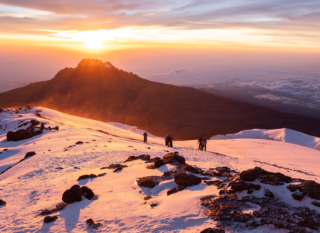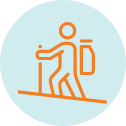
Difficult Tanzania
Our Mount Kilimanjaro expedition is meticulously designed for safety, unforgettable experiences, and personal transformation. Drawing from over a hundred successful climbs, we've curated every aspect of this climb, including a nutritious food menu to enhance acclimatisation, regular health checks to keep track of your progress and clean private camping facilities including our own toilets to maintain personal hygiene. Our expert LHO Team Leaders collaborate closely with our local guides and porters to prioritise your safety and ensure you return with the cherished memories of a life-changing journey.

TRIP TYPE
Trekking, Summit

DURATION
9 Days

DESTINATION
Tanzania
1
Guided by a specialised LHO Expedition Coordinator and senior Kilimanjaro guides, ensuring a seamless, safe experience, with full support on and off the mountain.
2
Relive the adventure with exclusive expedition photography captured by your LHO Team Leader, included as part of our standard offering.
3
100% safety record, high hygiene standards, quality meals, and camping infrastructure including private toilets, ensuring a comfortable and secure experience.






2026
DATE & STATUS
PRICE
TEAM LEADER
AVAILABILITY
WHAT'S INCLUDED IN THIS TRIP
WHAT'S NOT INCLUDED IN THIS TRIP
DAY 1: JAMBO KILIMANJARO!
Upon arrival at Kilimanjaro International Airport, you will be met by a member of the LHO team and transferred via private shuttle to the hotel, where your LHO Team Leader will be waiting to greet you. Once you have settled in, we will conduct a gear check to ensure you have everything you need for the climb.
If you arrive early, you can explore the lively town of Moshi at the base of Kilimanjaro. Coffee lovers should try Union Coffee Shop. Your Team Leader will share more recommendations closer to your trip.
In the evening, we will gather for a team dinner and briefing, either at a local restaurant or our hotel depending on group needs. This is your first chance to meet fellow climbers and your lead guides, ask questions, and learn more about the adventure ahead. We will make sure you are well prepared and rested for the days to come.
DAY 2: THROUGH THE TOWERING RAINFOREST
Distance: 10 KM | Ascent: 1220 M | Descent: 22 M | Max Altitude: 2,835 M
Our first day on the trail begins after breakfast and hotel checkout. We will take a private shuttle to the Machame gate, about an hour away, and complete park check in. This process can take around one hour, during which a hot lunch will be served at the gate.
The trail starts in the lush rainforest, with chances to spot wildlife like monkeys. This section features beautiful flora and a mix of steep and gentle inclines. Our LHO team will guide you to a comfortable and sustainable pace to ease into the rhythm of Kilimanjaro. We expect to reach Machame Camp at 3000 meters near sunset, where dinner awaits.
For many, this may be the first night ever camping. We will provide a short induction on campsite etiquette, how to use our private bathrooms, where to find tea, coffee, or hot water, and tips for maximizing comfort inside your tent.
DAY 3: THE MOUNTAIN OPENS UP
Distance: 5 KM | Ascent: 865 M | Descent: 50 M | Max Altitude: 3,840 M
On our second day, we start early, leaving the rainforest behind and entering the short grass zone. The first morning can feel a bit overwhelming with packing, breakfast, and health checks, but your LHO Team Leader will be there to guide you through it.
As we begin hiking, the jungle slowly gives way to alpine terrain. Vegetation shrinks, and wide open views emerge. The trail becomes rockier, replacing the rainforest mud. By midday, we reach Shira Camp at 3,700 meters, named after the now collapsed Shira crater. A hot lunch is served on arrival.
The afternoon is yours to relax, adjust to the altitude, and take in sweeping views of Mount Meru on the horizon. The contrast in landscape from the previous day is striking and energizing. Dinner is served at camp as we prepare for our continued ascent toward the summit of Kilimanjaro.
DAY 4: A TOWER OF LAVA
Distance: 10 KM | Ascent: 820 M | Descent: 680 M | Max Altitude: 4,600 M
This is one of the longest and most important trekking days, designed to help us acclimatize properly. We start earlier than usual to get ahead of the afternoon rains that often reach Lava Tower by midday due to Kilimanjaro’s microclimate.
We ascend to nearly 4,600 meters at Lava Tower before descending to Barranco Camp at 3,900 meters. This high route helps our bodies adjust to the altitude. A hot lunch will be served in our common tent at Lava Tower, followed by a scenic descent to Barranco, where a hot dinner awaits.
The terrain transforms dramatically as we cross the alpine desert, surrounded by striking rock formations from past eruptions. Snow is sometimes seen on this part of the trail. As we descend, we pass through a forest of Dendrosenecio Kilimanjaro trees, a rare species found only on this mountain. This day is a key milestone in preparing both body and mind for the summit ahead.
DAY 5: THE BARRANCO WALL
Distance: 4.2 KM | Ascent: 400 M | Descent: 350 M | Max Altitude: 4,200 M
The Barranco Wall rises 300 meters above our camp. From a distance, it may appear daunting, but as we approach, the route reveals itself. A short walk from camp brings us to the base, and the ascent begins. It is one of the most exciting days of the trek, filled with great photo opportunities and a sense of adventure.
After reaching the top, the trail levels out, and we continue along well marked terrain. Our goal is to reach Karanga Camp in time for a hot lunch.
The rest of the day is dedicated to rest and acclimatization. Relaxing at Karanga is essential, as this is our final opportunity to recover fully before our summit attempt. Your LHO team will be on hand to monitor how you are adjusting to the altitude and to help you prepare mentally and physically for the challenging days ahead.
DAY 6: BASE CAMP TO THE SUMMIT
Distance: 3.7 KM | Ascent: 640 M | Descent: 25 M | Max Altitude: 4,550 M
This is the shortest day on the mountain. The walk to Barafu Camp at 4600 meters is both scenic and brief, with the summit ridge of Kilimanjaro visible above us throughout the hike. Before setting out, we conduct a routine health check. This one is especially important, as it determines whether you are cleared to proceed into higher altitude.
We approach the day with a focused mindset, mirroring our summit night strategy with short breaks and a slow, steady pace. Upon arrival at Barafu, we have lunch and receive a full summit briefing.
The afternoon is reserved for rest and preparation. Dinner is served earlier than usual to allow for adequate sleep before the summit attempt. Around midnight, we wake up to begin our final push toward the roof of Africa.
DAY 7: THE ROOF OF AFRICA
Distance: 16 KM | Ascent: 1250 M | Descent: 2800 M | Max Altitude: 5,895 M
We typically start walking between midnight and 1 am, depending on the group’s pace. Before we set out, you can grab snacks, biscuits, and hot tea. The steepest section comes first as we exit Barafu Camp, climbing over rocky terrain similar to our approach to Shira Camp. After 30 minutes, the trail levels out near Kosovo before rising again via long switchbacks toward Stella Point. This is where the altitude gain is most intense.
From Stella Point, it is a 40 minute walk to Uhuru Peak, with glaciers beside us and the crater ridge below. On clear days, you can see the Savanna stretching into Tanzania and Kenya. Your LHO Team Leader will capture the moment as you take the final steps to the summit.
After photos and a short celebration, we descend to Barafu for lunch and rest, then continue to Mweika Camp at the edge of the rainforest, where deep sleep awaits.
DAY 8: SHOWERS & FAREWELLS
Distance: 8.6 KM | Ascent: 0 M | Descent: 1444 M | Max Altitude: 2,800 M
The final morning is always bittersweet. While we look forward to a hot shower and reflection, it is hard to say goodbye to the people who made this journey possible.
Before setting off on our last three hour descent, the LHO team hosts a farewell celebration at camp. Our porters, guides, chefs, and staff come together for one final send off. This is also the time to offer tips, and your Team Leader will privately guide you through the process.
After a full team photo, we begin the descent from Mweika Camp through the lush rainforest to the national park gate. Lunch will be served at the gate as our staff complete the final check out procedures.
We then return to the hotel for well deserved showers and rest. That evening, our adventure concludes with a celebratory team dinner hosted by your LHO Team Leader and any remaining LHO guides.
DAY 9: HAKUNA MATATA RAFIKI!
The final day is dedicated to airport transfers. Breakfast is included at our hotel. Team members will be shuttled to the airport depending on flight times. Please be sure to communicate the correct flight times when you fill out your Team Details Form prior to this experience. Please make sure to communicate any changes to your LHO Team Leader as early as possible to ensure that arrangements are made.

OUR COMMITMENT
We are dedicated to ensuring that everyone involved in our services receives a fair living wage in their respective countries. We invest in our team members, fostering upward mobility within the adventure travel industry, expanding educational opportunities, and offering support wherever we can. By joining an LHO adventure you are directly impacting the incredible people and the remote communities that make these life-changing experiences possible.
LEARN MOREHEALTH & SAFETY GUIDELINES
We do our best to ensure your wellbeing on LHO adventures. That's why the facilities we use throughout our trips are required to meet our health and safety standards. We also follow the laws and protocols of every country that hosts our adventures. This extends to national regulations requiring Covid-19 testing, vaccination certificates, mask wearing or any other local guidelines that may apply. Contact us for the most up to date protocols related to your destination.
LEARN MOREHow long does it take to climb Mount Kilimanjaro?
Climbing Mount Kilimanjaro typically takes 6 to 8 days, depending on the route and acclimatisation needs. The Machame route, our post popular trail, is commonly done in 7 or 8 days, offering great scenery and altitude adaptation. The Marangu route, our close second, takes 6 to 7 days, while the steep Umbwe route, rarely trekked, is often done in just 4 to 5 days. The least common Northern Circuit is the longest, taking 8 to 10 days. At Life Happens Outdoors, we recommend a 7 day itinerary as the ideal balance between effective acclimatisation and avoiding fatigue from prolonged exposure at high altitude.
When is the best time to climb Kilimanjaro?
The most important factor when choosing when to climb Kilimanjaro is avoiding the rainy season. Although Kilimanjaro has its own microclimate and weather can be unpredictable, dry season climbs significantly reduce the chance of sustained heavy rain, which can impact the experience.
The best times to climb are:
June to October
Mid December to end of February
There is no major difference in trail conditions between these two windows. Your choice depends on personal preference and availability. While dry season does not guarantee clear skies, it offers the best chance for a safe and enjoyable trek.
These seasons matter because they directly affect trail conditions, cloud cover and rainfall, which in turn impacts comfort, visibility and summit success.
How hard is it to climb Kilimanjaro?
Climbing Mount Kilimanjaro is challenging, but it is not technical. The difficulty comes from walking for several consecutive days, managing fatigue, and adapting to high altitude as you approach 5,895 metres. With thinner air, your pace slows, recovery takes longer, and symptoms can appear even in fit hikers.
The biggest success factors are steady pacing, hydration, sleep, and mindset. At Life Happens Outdoors, we reduce risk by keeping a controlled summit pace, running regular health checks, prioritising nourishment and hydration, and maintaining strong hygiene standards so you stay as resilient as possible on the mountain.
Can a beginner climb Kilimanjaro?
Yes. Many first time trekkers choose Kilimanjaro because it is a non technical trek and does not require mountaineering skills like rope work or ice climbing. If you can train consistently and you are comfortable walking for multiple days in a row on uneven terrain with a light daypack, you can absolutely be ready for this challenge.
Altitude is the main factor, not technique, so the best preparation is building hiking endurance and learning how to pace yourself steadily. For a clear step by step plan, read our Kilimanjaro training guide.
How do I prepare to climb Kilimanjaro?
Start training 8 to 12 weeks before your departure and focus on consistency rather than intensity. Aim for 3 to 5 sessions per week, including one long hike each week that gradually builds up to several hours on your feet. Add one stair or hill session weekly to prepare your legs for sustained uphill effort, and do basic strength work 2 times per week focusing on legs and core.
Also train in the footwear and daypack you will use on the mountain so you can dial in comfort and avoid blisters. For a full week by week plan, read our Kilimanjaro training guide.
Do you need oxygen to climb Kilimanjaro?
No. Most people do not need supplemental oxygen to reach the summit of Kilimanjaro when the climb is paced properly and you focus on acclimatisation, hydration, and nutrition. Life Happens Outdoors carries oxygen as an emergency backup only, and our primary approach is steady pacing, regular health checks, and close monitoring so we can respond early if anyone shows signs they need extra support or a descent.
Do I need prior trekking experience?
No. You do not need prior trekking experience to climb Kilimanjaro with Life Happens Outdoors. What matters most is that you prepare properly, train consistently, and arrive ready to walk for multiple days in a row on uneven terrain with a light daypack. Our Team Leaders and crew support you with pacing, guidance, and regular check ins throughout the climb so first time trekkers can feel confident from day one.
The most important thing to climb Kilimanjaro is to truly want it. If you want it, you’ll commit to the physical and mental preparation necessary to overcome the challenge.
Are there any vaccines or medications I need to take for Tanzania?
Health requirements depend on your nationality, where you are travelling from, and any recent countries you have visited or transited through. As a general checklist, ensure your routine vaccinations are up to date, and check whether a yellow fever certificate is required based on your travel history. Many travellers also discuss malaria prevention with their clinician, as recommendations can vary by season and itinerary.
For the most accurate guidance, review official travel health advice for Tanzania and speak with your doctor or a travel clinic well before departure.
What's the toilet situation?
There are fixed toilets at the campsites and at some points along the trail, and they are generally well maintained. At camp, we also provide a private toilet tent for our group, with a 4 to 1 ratio, which most people prefer for comfort and hygiene. If you would like even more privacy, you can upgrade to your own personal toilet setup at the campsite. On the trail, you will use the designated facilities when available, and we do not encourage anyone to go in nature, especially at higher altitude where waste does not break down properly and can remain frozen on the mountain.
Where does the drinking water come from?
Drinking water is sourced from local springs on the mountain, then boiled and treated to ensure it is safe to drink. You will have unlimited treated water refills throughout the expedition. During the day, most climbers carry their water in either refillable bottles or a hydration bladder, and we generally aim for around 3 litres per day, adjusting based on conditions and how you are feeling.
What's the temperature and weather like?
Kilimanjaro gives you multiple climates in one expedition. Summit night is the coldest, with temperatures that can drop to around -15°C, while daytime temperatures can reach 20°C or more in calm conditions. Nights at camp are often around 0°C, and even in the dry season the rainforest can be wet due to humidity and cloud.
Our gear list is designed to keep you comfortable through every zone, from warm lower trails to freezing summit conditions.
What is included in the price?
Your trip price includes airport to airport support in Tanzania, all on mountain and off mountain accommodation, park fees and permits, the full mountain crew, group camping equipment including sleeping mats and LHO duffle bags, a curated food menu designed to match macros with acclimatisation and recovery at every phase of the trek on the mountain, meals in Moshi starting with your welcome dinner on arrival day and ending with breakfast on departure day, unlimited treated drinking water refills, and Life Happens Outdoors Team Leader support and photographer throughout.
Your international flights, visa fees, travel insurance, personal gear, tips, and personal snacks are not included.
How much should I budget for tips on Kilimanjaro?
Tips are not included in the trip price. As a guideline, plan a tip budget per climber for the full mountain crew, with the exact amount depending on group size and the duration of the climb. We will share a clear recommended tipping range in your pre departure briefing and we coordinate the process on trip so it is simple, fair, and handled respectfully.
Do I need a visa for Tanzania and how do I get it?
Visa requirements depend on your passport and where you are travelling from. Many travellers can obtain a Tanzanian visa online in advance or on arrival, but rules can change, so we recommend checking the official Tanzanian visa guidance for your nationality well ahead of departure. If you need support, our team will point you to the correct official process during your pre departure planning.
What insurance do you require?
Travel insurance is required and must cover high altitude trekking and emergency medical evacuation, including evacuation by helicopter where applicable. Your policy should also cover overseas medical treatment, trip cancellation, and personal belongings. We will confirm the minimum coverage requirements with you before departure so you can purchase the right level of protection.
What happens if I get altitude sickness and need to descend?
Your safety comes first. If you show signs of altitude illness, our team responds early with rest, hydration support, and close monitoring, and if symptoms do not improve or worsen, we begin a controlled descent. Our crew is trained to manage these situations, and we have emergency protocols and equipment in place. In serious cases, evacuation may be arranged, and this is why the right insurance is essential.
How do your health checks work on the mountain?
We run regular health checks in the morning and evenings throughout the expedition, especially as altitude increases. This typically includes monitoring how you feel, checking key indicators including blood oxygen levels, and making sure you are eating, drinking, and recovering well. These check ins help us spot issues early, adjust pacing, and support acclimatisation so you stay in the strongest position possible for summit night.
How do payment plans work?
Payment plans are available. Typically, you secure your place with a deposit, then pay the remaining balance in scheduled instalments before departure. If you would like a payment plan, contact our team and we will confirm the deposit amount, instalment dates, and the simplest way to set it up for your booking. In some jurisdictions, you may also be able to pay using Klarna or PayPal Pay Later at checkout, subject to availability and approval in your country.
How fit do I need to be and how far in advance should I train?
You do not need to be an athlete, but you do need a solid base of walking endurance. Plan to train for 8 to 12 weeks before departure, building up to longer hikes and consistent weekly activity. The goal is to be comfortable walking for several days in a row on uneven terrain while carrying a light daypack, with enough fitness left to manage altitude and recovery.
What can I charge on the mountain and what power options exist?
There are no charging opportunities on the mountain, so you must bring enough power banks to sustain you for the full expedition. For most people, two good quality power banks is usually enough to cover phones, headlamps, and watches for the entire trip, but if you are bringing cameras or multiple devices you will need to plan additional capacity and spare batteries. High quality solar power banks can also work well now as a backup, especially in the higher camps with strong sun.
How much weight can my duffel be and what do I carry in my daypack?
Your main duffel is carried by the crew, and we aim to keep it between 12.5 kg and 14 kg. Park rules can allow up to 16 kg, but at Life Happens Outdoors we prefer to stay conservative and avoid unnecessary loads on our porters whenever possible. If you do exceed 16 kg, it is possible to purchase extra weight, which requires an additional member of the portering team to join.
You carry a daypack during the day with essentials like water, layers, snacks, sunscreen, and personal items. As a guideline, we recommend keeping your daypack as light as possible, ideally around 4 kg to 5 kg. If you would like extra support, Life Happens Outdoors can also arrange an upgrade to a personal porter for the duration of the trek to carry your daypack for you.
Can you cater for dietary requirements?
Yes. We can cater for many common dietary requirements with advance notice. Let us know your needs during booking so our team and mountain crew can plan appropriately, and we will confirm what is possible for your specific requirement.
What is the group size and guide to climber support ratio?
Our maximum group size is 12, so the experience stays personal and well supported. We operate with a 3 to 1 guide to climber ratio, and on summit night we provide a 1 to 1 support staff to trekker ratio, excluding your Life Happens Outdoors Team Leader who coordinates the entire expedition with you on the mountain. If you would like the expected group size for a specific date, contact us and we will confirm what that departure looks like.
PAYMENT PLANS AVAILABLE
FROM £2,980
DOWNLOAD YOUR TRIP GUIDEBOOK
INQUIRE NOW
This adventure is only available as a private trip and is customized to your requirements, experience and skill level. To get started, please fill out the form below. We’ll be in touch soon to put it together for you.
"(Required)" indicates required fields
CONTACT US
We’re passionate about guiding you to epic adventures and beyond. If you have any questions at all, don’t hesitate to reach out. We’d love to hear from you.

